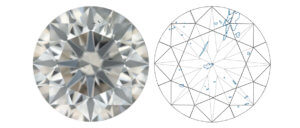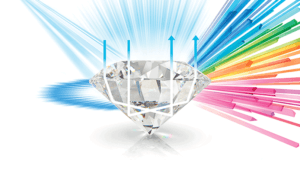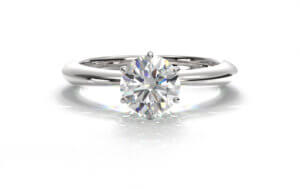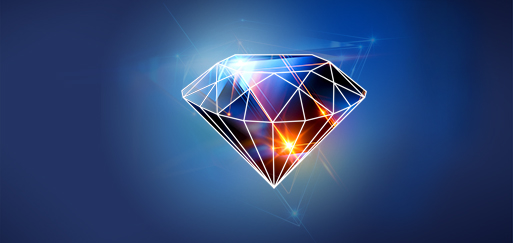If there is one word that everyone associates with diamonds, it is “sparkle.” The bright, sparkling appearance of diamonds is part of what makes them such a highly sought-after prize.
Diamonds have been variously described as “sparkling”, “shining” and “flashing”. A sparkling diamond can be thought of as beautiful, or “bling-y”, yet if the diamond is suspected as a fake, then that same sparkle can suddenly become gaudy and undesirable. There is no doubt that the way a diamond sparkles, and how much it does so, is part of its unique character. It’s one of the reasons a woman will fall in love with a particular diamond, and choose it over the others in the display counter.
Yet, why do diamonds sparkle? What is it about diamonds that creates this desirable trait? While gemstones might be prized for their richness of color, how does the sparkle of a white diamond lend it an individual character? And finally, do diamonds really sparkle, do they shine, or is something else going on entirely?
Let’s dig in and answer the timeless question:
"Why do diamonds sparkle?”
Natural formation process
Diamonds are formed under intense pressure, very deep in the earth, over millions if not billions of years. For this reason, during the natural formation process, each diamond will develop internal ‘birthmarks’, known as inclusions. These are actually flaws in the diamond’s structure, yet most diamonds have them. Diamonds that are ‘flawless’, meaning they have virtually no inclusions or birthmarks, are exceedingly rare.
When a rough diamond is mined, the manufacturer will need to take the natural state of the whole rough into consideration when deciding how to cut it into a polished stone or stones. There are many factors to consider when planning how to cut a rough diamond - one of them is the number and position of inclusions inside the rough diamond. Why is this important? Because one of the key factors in the way a diamond sparkles is its particular arrangement of inclusions. Inclusions can block or hamper the movement of light waves inside a diamond, which significantly affects that way it sparkles in the light.

Cut
Unique structural birthmarks exist in every diamond, and they are unchangeable. This is something that the diamond cutter must work with. While birthmarks are a naturally occurring phenomenon over which we humans have no control, the way a diamond is cut is purely in the hands of the experts. An excellent cutting plan and gemological expertise can maximize the potential of the polished diamond that is extracted from the rough.
Firstly, the rough diamond must be planned and cut in such a way as to minimize the occurrence and appearance of inclusions in the polished result. Of course, if the rough diamond is heavily included, there may not be many cutting options that yield a truly sparkling result. Yet in other cases, this is indeed possible.
There are other aspects of cut, based on many decades of science and mathematical research, that help to create a more sparkly diamond. For example, if the pavilion (bottom part) of the diamond is too shallow or too deep, then the light will either leak out or be absorbed within the diamond, making it less sparkly to the eye of the viewer.

Color
Color can also affect the way a white diamond sparkles. A perfect, sparkly diamond is not really ‘white’. It is in fact colorless; the absence of color is what gives diamonds their pure clear appearance, much the same as water.
However, most diamonds are not colorless - rather, they tend to have a tinge or hue that can range from mildly tinted to a dark yellow color. When it comes to a diamond’s sparkle, the influence of color is only really discernible with lower color grading. The duller hue tends to inhibit the diamond’s sparkling appearance. With diamond’s that have a good color grade, cut has a much more significant impact on the sparkle factor.

Light performance
Unlike other gemstones, a diamond’s appearance is a direct result of the way it interacts with light. When light enters a diamond, it bends or refracts, and then exits again. The particular play of light is reflected back to the eye of the viewer, and this is what gives the diamond its sparkle and life. This is also the reason why a diamond will appear to sparkle, or glitter, when it is moving or turning in different directions.
Light performance is a measure of the unique way a diamond interacts with light. The diamond’s natural structure (inclusions) and its cut, both discussed above, have a significant impact on the way the diamond performs in the light. There are infinite variations of the way a diamond plays with light, so each diamond has its own individual light performance measurements and grade.
Video - Understanding Diamond Light Performance
Diamond shape
Diamonds are cut in a wide range of shapes. The classic round brilliant, based on the scientific work of Marcel Tolkowsky, is based on a faceted cut that maximizes the diamond’s interaction with light and creates the magnificent brilliance and sparkle that the cut is known for. This certainly contributes to the enduring popularity of the round brilliant over other diamond shapes.
Other diamond shapes, such as oval, marquise and pear, tend to sparkle less than the round brilliant, yet are still a sparkly alternative.
Diamond shapes with less complex faceting, such as emerald, asscher and baguette, tend to have the least sparkle.

Jewelry setting
It’s not just the diamond itself that affects its sparkle. The way the diamond is set can have a significant impact.
When it comes to rings, prong settings or tension settings tend to sparkle more, as the diamond is more exposed to light. Bezel settings, which enclose the diamond on all its sides, block the light so the diamond will sparkle less.
Yellow gold settings can highlight the tinge in the diamond’s color, making it look dull and less sparkly, while white gold can enhance the appearance of sparkle. On the other hand, a lower color graded diamond set in white gold can appear duller, as the white contrasts and highlights the diamond’s hue.

Finding the right diamond sparkle
One of the most important things to remember when considering the question, “why do diamonds sparkle?” is that the sparkle factor is a consequence of a number of interacting forces. If you want to maximize sparkle, then make sure to choose a diamond that has a better light performance grade. If the sparkling diamond you love is out of your price range, then go for a more affordable diamond with lower light performance, but make sure to choose a round brilliant in a jewelry setting that enhances the existing sparkle.
Although diamond sparkle is very important to some, others may prefer a lower key diamond. In this case, there is the option of choosing a diamond shape that is inherently less sparkly than the classic round. When it comes to diamond sparkle, there’s no right or wrong. A diamond’s visual beauty is truly in the eye of the beholder.




-1.jpg?width=310&name=blog_image%20(003)-1.jpg)





